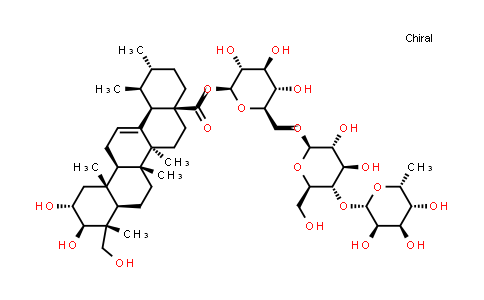Introduction of 16830-15-2 :
Asiaticoside, a trisaccaride triterpene from Centella asiatica, suppresses TGF-β/Smad signaling through inducing Smad7 and inhibiting TGF-βRI and TGF-βRII in keloid fibroblasts; Asiaticoside shows antioxidant, anti-inflammatory, and anti-ulcer properties. IC50 & Target: TGF-beta/Smad[1] In Vitro: Asiaticoside (0, 100, 250, and 500 mg/L) dose-dependently inhibits keloid fibroblasts proliferation. Asiaticoside (100, 250, and 500 mg/L) decreases the expression of collagen protein and mRNA, reduces the expression of TGF-bRI, TGF-bRII protein, and mRNA, increases the expression of Smad7, but does not affect Smad2, Smad3, Smad4, phosphorylated Smad2, and phosphorylated Smad3 in keloid fibroblasts[1]. Asiaticoside (12.5 and 50, and 25 and 50 µg/mL) prevents endothelial cells from hypoxia-induced inhibition of cell viability and NO production. Asiaticoside (50 µg/mL) also protects endothelial cells from hypoxia-induced apoptosis and upregulates and phosphorylation of AKT/eNOS in hypoxia-exposed HPAECs[2]. In Vivo: Asiaticoside (50 mg/kg daily) blocks the development of hypoxic pulmonary hypertension (PH), cardiovascular remodeling and endothelial cell injury in rats with pulmonary hypertension[2]. Asiaticoside (5, 15 or 45 mg/kg, p.o.) improves the learning and memory deficit, protects hippocampi against the impairment, decreases Aβ deposits in the hippocampus, and ameliorates impaired subcellular structure in rats treated with Aβ oligomers[3].
